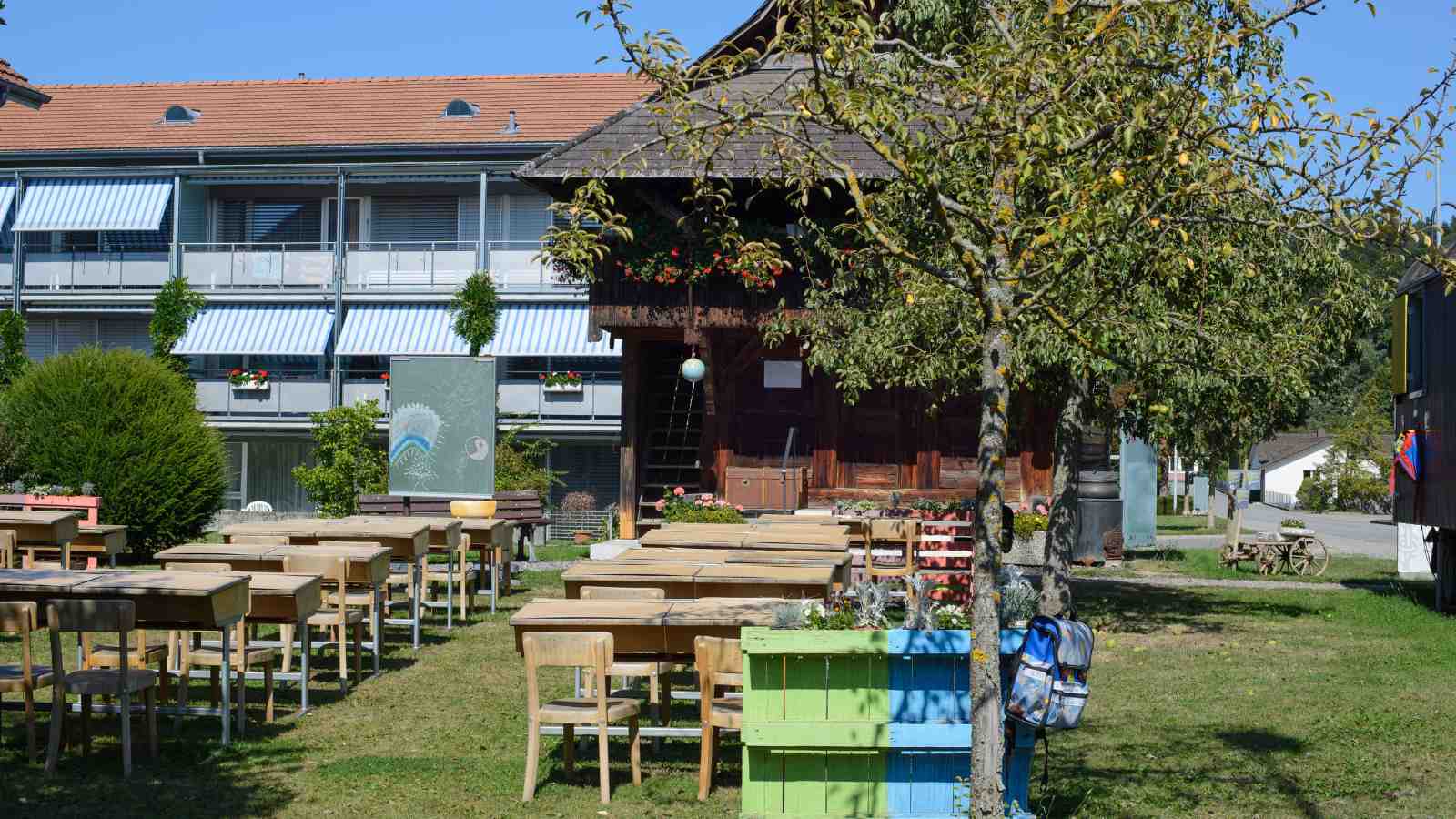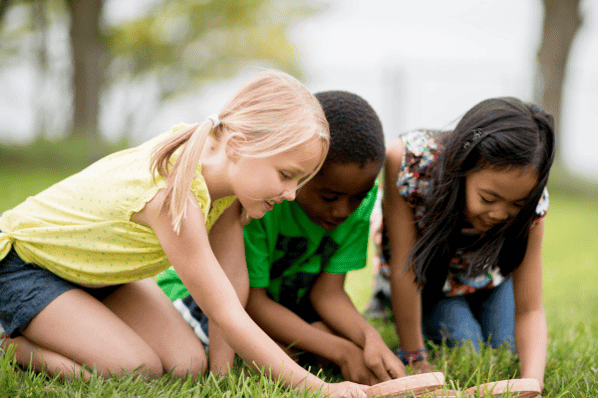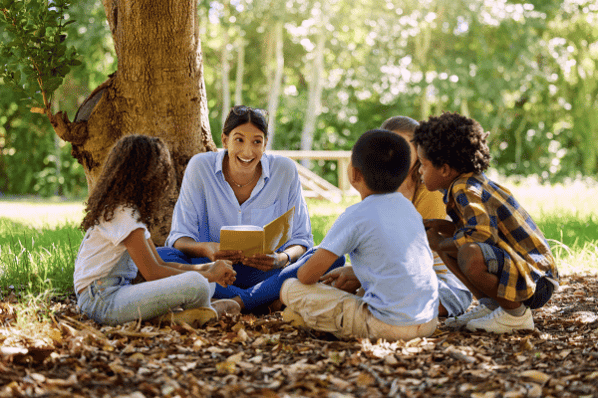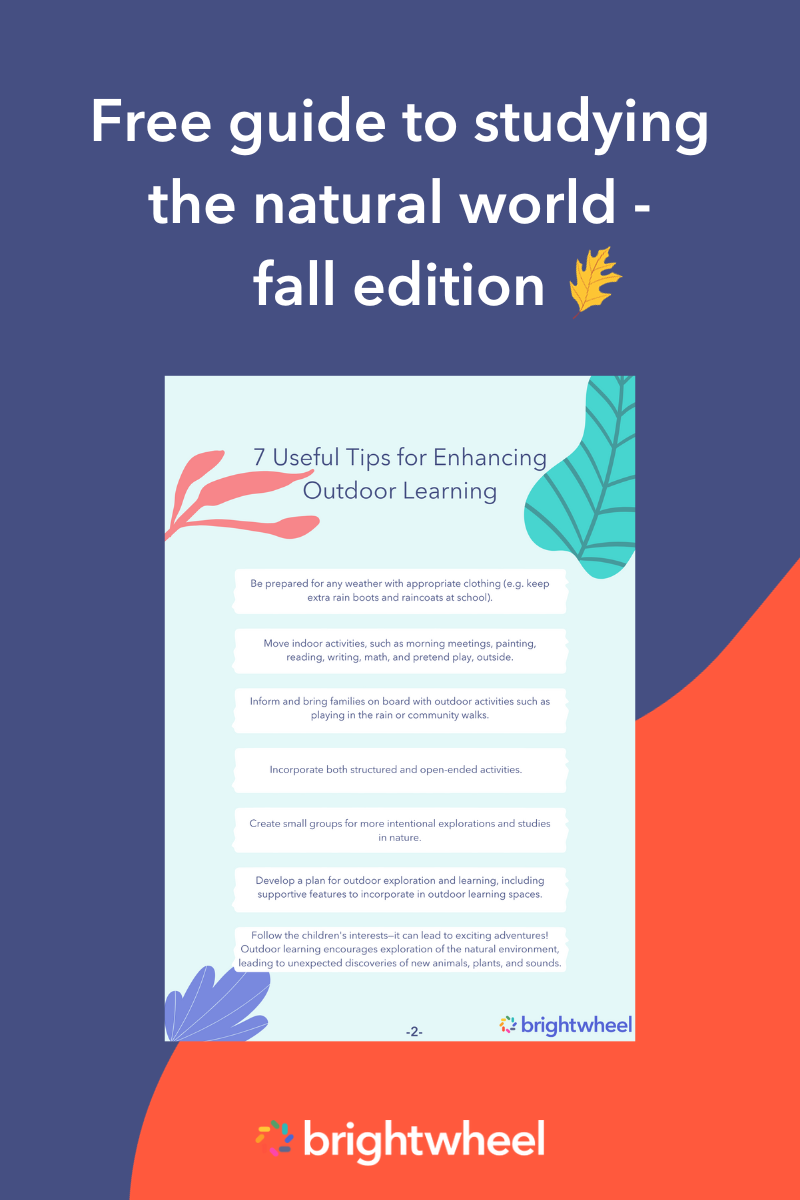
Educators are increasingly recognizing the importance of outdoor play and are incorporating outdoor classrooms into their programs. Outdoor classrooms allow children to explore and discover the world around them.
Exposure to the natural environment enhances children’s creativity and imagination as they play and explore. It also improves social skills and teamwork as they interact with other children. When used effectively, outdoor classrooms are powerful learning environments that promote the holistic development of young children.
If you are considering creating an outdoor classroom or want to enhance your current program, this article will give you essential information to get started.

What is an outdoor classroom?
An outdoor classroom is a learning environment outside of a traditional indoor classroom setting. Outdoor classrooms can be created in various settings, including parks, gardens, playgrounds, and farmlands.
While outdoor classrooms take on many different forms, they all share a common goal: to create an immersive learning experience that takes advantage of the unique benefits of being outdoors.
Manage your preschool classroom (whether indoor or outdoor) with brightwheel's classroom management feature. Track student attendance from the brightwheel app and develop comprehensive schedules to manage class capacities and ratios. Save time on lesson planning by using existing lesson plan templates and easily share classroom highlights with families.
Benefits of outdoor learning
Outdoor learning is gaining popularity in early childhood education for a good reason. From improved social skills to enhanced brain development, children reap many benefits from spending time in nature.
Increased physical activity levels
Children who spend more time outdoors are more physically active than those who stay indoors. They are also less likely to become obese or develop chronic health conditions like Type 2 Diabetes.
Improved gross and fine motor skills
Playing outdoors improves children's gross motor skills, such as running, jumping, and climbing. They also refine fine motor skills by picking up small objects or manipulating playground equipment.
Better social skills and cooperation
Outdoor play gives children the opportunity to interact with other children and adults. This develops their social skills, such as communication, turn-taking, and sharing. They also learn to cooperate with others to achieve a common goal.
Greater creativity
Engaging in imaginative play, such as make-believe games, boosts children's creativity. Children who play outdoors are likely to score higher on tests that focus on creative thinking than those who stay indoors.
Enhanced problem-solving skills
Outdoor play allows children to solve problems and figure things out for themselves. For example, they may need to work out how to use a piece of playground equipment or figure out the rules of a game. The critical thinking and problem-solving skills children develop through outdoor play will help them to succeed in school and later in life.
Deeper understanding of the natural world
Spending time in nature helps children learn to appreciate and respect the environment. When children discover new plants and animals, learn about the changing seasons, or explore different habitats, they develop a greater understanding of the world around them.
Improved mental well-being
Spending time outdoors reduces stress and anxiety and increases feelings of happiness, relaxation, and calm. Being in nature also increases self-esteem and self-confidence. When children feel good about themselves, they are more likely to cope better with challenging situations and reach their full potential.
Increased risk-taking and resilience
Children need opportunities to take risks and experience failure in a safe and supportive environment. Being outdoors increases risk-taking and resilience because it inherently comes with more risks. This environment has a lot of variables that are out of their control, which allows children to explore more widely, make mistakes, and learn from them.
Risk-taking develops essential life skills such as resilience, adaptability, and resourcefulness. It also encourages children to be curious, exploratory, and think outside the box.
Engaged learning
When children explore, use their imaginations, and are active in a new environment outside of their typical classrooms, they tend to be more engaged and motivated to learn new skills. Outdoor play helps stimulate learning and builds excitement around different activities.

Outdoor classroom ideas
Children learn best through play. The outdoor environment provides endless opportunities for creative and imaginative play. Before you start planning your outdoor classroom, it's essential to ask yourself the following questions:
- What is the age range of the children in your care?
- What are their interests and abilities?
- What type of activities do you want to include?
- What is the size and layout of the outdoor space?
- What type of equipment and resources do you need?
Here are some ideas to get you started:
A forest school
Based on the Scandinavian concept of "friluftsliv," meaning "free air life," forest schools are focused on living life with an appreciation for nature. They are designed to help children develop a strong connection with the natural world and understand how they depend on it. They also provide opportunities for children to play and learn in a natural environment and develop confidence, self-esteem, and a love of nature.
To create a forest school, you need access to a wooded area or park where children can freely explore. The area should have a variety of plants and trees, as well as open spaces for running and playing. Make sure to include safety measures such as boundary markers or flags, and ensure the environment is clean and safe.
Children can explore, play games, build shelters, go on scavenger hunts, do art projects with natural materials, and more in a forest school.
A beach school
Beach schools offer a unique learning environment, with the sea, sand, and waves providing a backdrop for exploring, investigating, and playing.
To create a beach school, here's what you will need:
- A stretch of beach that is safe for children to play in
- Shade tents or umbrellas
- Sunscreen and hats
- Beach toys such as buckets, spades, and fishing nets
- Waterproof bags for storage
Beach schools help children to develop an understanding of the natural world and respect for the environment.
A farm-based classroom
A farm-based classroom helps children appreciate where their food comes from and understand the importance of looking after animals and crops. They can learn about the different farm animals, how they are cared for, and what they eat. They can also help to feed the animals, collect eggs, and harvest fruits and vegetables.
A mud kitchen
A mud kitchen is an outdoor kitchen area filled with natural and recycled materials that can be used for creative play. Children can make their own "recipes" using natural materials such as leaves, sticks, and mud. Mud kitchens help children develop their fine motor skills and use their imaginations.
A water play area
A water play area can be a great sensory learning environment for children. It can be as simple as a basin filled with water, or you could include a water pump, sprinklers, and other water toys.
A sandpit
A sandpit allows children to practice their fine motor skills by digging, scooping, pouring, and raking sand. They can also learn about measurement, volume, and weight as they fill and empty buckets of sand.
A sensory garden
A sensory garden stimulates the senses. It might include features such as different textures, scents, and sounds. For sounds, choose plants that make noise when the wind blows, such as ornamental grasses or bamboo. For scents, you could include herbs, flowers, and citrus fruits.
A music garden
Listening to and making music benefits children's development. To build a music garden classroom, bring musical instruments such as drums, shakers, and bells outside for children to use and encourage them to experiment with the different sounds they can make.
An outdoor art area
Preschoolers love to express their creativity, and an outdoor art area is a perfect place to do it. Set up a table and chairs with supplies like crayons, markers, paint, and paper. Add some nature-inspired elements like sticks, leaves, and flowers for collages.
Have the children sit at the table and create their masterpieces. When they're finished, hang their artwork up to dry.
A loose parts area
Loose parts are materials that can be moved, manipulated, and combined differently. They include items like balls, blocks, clothes, cardboard boxes, and egg cartons.
Set up a designated area with loose parts. Ask the children to build towers, houses, or whatever else they can imagine. Let them be creative and have fun.
A nature scavenger hunt
Make a list of items for children to find in an outdoor scavenger hunt, such as a leaf, a flower, a rock, and a stick. Add in some challenges, like finding something that is red or finding something that smells nice.
Hide the items outside and let the children go on a hunt. They can mark off the items as they find them. This activity helps to develop observational skills and encourages children to explore their surroundings.
An obstacle course
Create a course with different obstacles for the children to overcome. This includes balance beams, crawling through tunnels, jumping over hurdles, and walking along a line. Alternatively, set up an outdoor play area with different climbing and crawling equipment. An obstacle course can help children develop gross motor skills and coordination, and it can also foster a sense of achievement.

Outdoor classroom furniture
When designing your outdoor classroom, ensure the furniture creates a comfortable and inviting space for children to learn and play. When choosing outdoor classroom furniture, consider the age and abilities of your children. For example, preschoolers will need lightweight and easy-to-move furniture. And above all else, the furniture should be safe, durable, and easy to clean.
Arrange it in a way that encourages collaboration and communication. For example, arrange tables and chairs in a circle. Provide various engaging outdoor activities and materials, so everyone finds something they enjoy.
Here is the most popular outdoor classroom furniture:
Picnic tables
When choosing picnic tables, consider the height of the table and the size of the seats. Group picnic tables together to create a large communal space for art activities and eating. Arrange them in a circle or square to encourage social interaction and communication.
You can also use picnic tables as individual desks for children to do their work. If you choose this option, have enough storage space for books and other materials such as crayons.
Chairs
Have a variety of chairs available for children of different ages and abilities:
- Sturdy, adult-sized chairs for supervision and storytime
- Bucket chairs or bean bag chairs for cozy reading spaces
- Low-to-the-ground chairs or mats for younger children
- Stools or standing desks for active learners
Arrange the chairs in a circle for group activities or in rows for individual work.
Sofas
Sofas provide a comfortable place for children to read, relax, and take breaks. Create small groups or reading nooks by arranging two or three sofas together.
Tables
When choosing tables for your outdoor classroom, consider the activities that will take place there:
- Large, rectangular tables for arts and crafts projects or group work
- Round tables for social activities and games
- Small, individual tables for reading and writing
Place the tables together in groups or leave them spread out around the space.
Benches
Benches are versatile pieces of outdoor furniture. They can be used for seating, storage, or work surfaces.
Place benches along the perimeter of the space for individual or group work. Or use them to create a social area for children to interact or relax.
Storage bins
Outdoor classrooms can get messy. Have plenty of storage bins for materials, art supplies, books, and toys. Label the bins so that children know where everything goes.
Rugs
Rugs can help define the space and add color and pattern. Use rugs to create different areas in your outdoor classroom. For example, you can place a rug under the picnic table for art time or in the reading nook for storytime.
Canopies
Outdoor canopies create an outdoor classroom space that is comfortable and protected from the elements. They can provide shade on hot days or create a dry, protected space in case of inclement weather. Canopies also create a private, intimate space for small group work or one-on-one instruction.
Place the canopy in an open area and make sure there is enough space for all children to move around freely and access all materials.
Ottomans
Ottomans are versatile pieces of furniture that can be used for seating, storage, or as a table.
Arrange the ottomans in a circle for group activities or in rows for individual work. Use them to create a quiet area for children to relax or use them as a table for arts and crafts.
Final thoughts
Outdoor classrooms provide a unique and beneficial learning experience for young children. Exploring and learning outside of a traditional classroom setting improves children’s social and physical skills and helps them develop a greater appreciation for and connection with nature.
Educators can enhance their teaching methods by taking advantage of their unique outdoor environments and incorporating various activities outside whenever possible.
Brightwheel is the complete solution for early education providers, enabling you to streamline your center’s operations and build a stand-out reputation. Brightwheel connects the most critical aspects of running your center—including sign in and out, parent communications, tuition billing, and licensing and compliance—in one easy-to-use tool, along with providing best-in-class customer support and coaching. Brightwheel is trusted by thousands of early education centers and millions of parents. Learn more at mybrightwheel.com.


